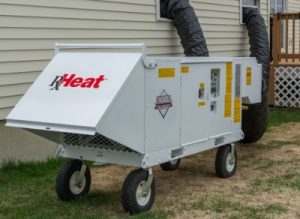
We are living at the times when protection of the environment is not only what a long-haired hippy care about. Green has gone mainstream.
More and more people are looking for better, more eco-responsible ways of handling everyday problems, previously solved with chemicals.
The same goes about termites, before you start pouring gallons of Termidor onto your soil, think, maybe there’s less toxic solution.
For example, one of the most natural ways of handling the termite infestation is a heat treatment. Let’s learn more about the process – killing termites with heat. The termite heat treatment reviews are below.
Hide content
- Which termites does heat help to kill?
- How does termite heat treatment work?
- What are the possible heat treatments?
- Useful articles
- Helpful video
- Burn, baby, burn!
Which termites does heat help to kill?
Well, logically, any termite will die from the extreme heat, but there’s a small difference between the two major termite pests, that makes the heat efficient for ones and only slightly helpful for others.
These two groups are subterranean and drywood termites. The difference I’m talking about is their nesting habit.
The subterranean termites need not only food for the survival, but a source of the accessible moisture.
So, they build their nests under the ground, where they are well protected from direct sunlight and have enough humidity.
And this is why they are not the ones you should treat with heat. You see, you can warm up the object that is infested, or the whole building, but you cannot warm up the soil. So, even if you kick all the intruders out of your house, they still will appear again in a short time, because the nest is still thriving.You can use the heat treatment against subterranean termites in combination with the other methods, that will help you to destroy the colony (baiting, soil treatment). But as a sole method it’s just not efficient enough.
Learn more about subterranean termites: signs of their activity; best methods of treatment and DIY methods. Eastern subterranean termites and their tunnels and tubes with photo.
The drywood termites are the problem, that heat treatment can solve entirely. This pest is nesting the same place it’s eating. So, if you found the hollowed wood in your house, it doesn’t only mean that you’ve found the foraging workers, but the nest itself as well.
This is why you can use the heat for this group – warming up the whole building or one piece of wood, you kill all the alive termites inside and simultaneously destroy the colony.
Learn more about drywood termites: signs of their activity; best methods of treatment: spot treatment and DIY methods; how to get rid of them in furniture?
How does termite heat treatment work?
Does heat kill termites? Though you might know that preferable climate for termites is warm and humid, they do not like the extreme heat.
You’ll never see a termite crawling under direct sunlight.
For protection from drying out, the subterranean termites even build he mud tubes to shelter their passages.
So the temperatures over 120 degrees Fahrenheit for more than half an hour kill termites with a guarantee.
What are the possible heat treatments?
There’re several variants of the heat treatments for termites. They can be DIY or executed by professionals, used as a spot treatment of the localized infestation, and as the alternative to the whole structural tenting. Let’s go through our options.
Finding the right spot for treatment
If you are planning to get rid of the termites yourself using high temperatures, one of the most important things is to find the active nests in your house. Maybe, at least for the first time it will be better to trust his task to professionals.The thing is there’s still no perfect technology or equipment that can find the termites inside the walls or other structures, so, the pest operators are usually relying on their experience, which you don’t have. But, otherwise, you can try to look for those signs:
- Swarm;
- Frass;
- Hollowed wood.
Swarm is the time when the colony releases its winged reproductives, and they look for a mate and a place for the new colony. Obviously, if the colony is swarming – the colony is active, fully developed and easy to find.
The alates (winged swarmers) emerge right out of the nest, so if you witnessed the process – you know where to search for the treatment spot.
Even if you were not at home at the time of the swarm, the presence of shed wings might let you see, if the reproductives emerged from within the house or came from the outside.
Usually, alates don’t travel too far from their starting point, unless they were carried by the wind.
Frass is the universal sign for the drywood termites. The subterranean type usually doesn’t leave this clue. The frass is the excrements of the termites, that have the shape of granules and are kicked out from the holes in wood by termites.
They form the pellets of material, looking a lot like sawdust. The difference can be told if you take the magnifying glass and study the droppings. The frass elements differ in color, but have similar shape, the sawdust is evenly colored.
Otherwise you can simply exercise logic and deduce, that there’s no reason for the sawdust to be in the middle of the living room under the armchair. If you found the frass, clean it off, and check at the same place after few days. If the droppings reappear – you found an active nest.Hollowed wood can help you as well. To find it, you’ll need to tap with the dull end of the screwdriver on wooden surfaces, and if you found the hollowed or damaged timber, try to pick it with the sharp end.
There’s a chance, that you’ll see the termite workers inside, and then you’ll know it is an active infestation.
Here you can learn more information about effective termite control remedies: Bora-Care, Boric acid, Borate, Fipronil, Chlorpyrifos, Chlordane, Borax, Timbor, Termidor, Terminator, Phantom, Lorsban, Biflex, Terro. You can choose different forms, such as – foam, liquid, powder.
Treating the infestation yourself
There’re two ways you can deal with the infestation, using the heat treatment yourself.
First one – is to place the object under the strong direct sunlight. Better leave it for at least two days, so the wood warms up good.
Sadly, the guarantees of this method are quite low, but you have about 70% chance to kill the termites inside. The huge drawback – the efficiency depends wholly on weather conditions.
Another way, that is used on small objects, such as books, is heating it up in the oven. The professionals argue the efficiency of this treatment, but the house owners who tried it, are mostly satisfied.
The main limitation here is the size of the object and the size of your oven.
Important! Make sure that placing the object in the oven will not destroy its looks and functionality. Paint, lacquer and plastic can melt or get badly damaged in the process.Here you can learn more information about termite bait systems: Advance, Green, CSIRO, Nemesis, Exterra, Firstline, Terminate. Also find out how to make baits by yourself and how to refill them?
Professional help
Now, what do the professionals offer? First of all, some of the companies might offer you the alterative version of your oven – a heating room, where you can place the object essentially larger than the book.
This treatment will help you with some elements of the furniture. Just remember that the damage to the non-wooden materials can be done in the process.
Otherwise, the companies offer the full house tenting as an alternative to the structural fumigation. Heat treatment in this case have couple of advantages:
- The heat treatment is an absolutely non-toxic green method. There will be no chemical smell or any kind of residual afterwards, as the only gas that is used in the process is propane.
- Homeowners can come back to the house the same day after 8-9 hours, instead of staying somewhere else for 72 hours.
Though, not everything is perfect, the drawback of the full structural heat treatment are:
- The preparation for the treatment will take time and manpower. You need to not only remove pets and plants, but also all kinds of furniture or equipment, that can be damaged in the process.
- Even with all the precautions made, you still might destroy some wiring, that is irremovable, inside the walls.
- No residual means that after the treatment there’s no protection left and your house is exposed for the new infestation.
The process of the treatment is simple: the house is covered by the giant tarpaulin tent and then heated up to 150 degrees Fahrenheit with propane heat guns. The professionals look after the temperature with special monitors. This goes for several hours.Useful articles
If you interested in more information of termites we recommend you to read the following articles:
- All types of termites. Are they harmful to humans? Can they bite you? And what is the difference between drywood and subterranean ones?
- What does swarmers of different species look like: drywood, subterranean, formosan?
- Signs of infestation outside and in the house: in walls or furniture.
- How to treat them at home and in the yard: in wood or in fence. How long this process lasts and what is pre-construction and soil treatment?
- What does termite holes look like? What is droppings and is it toxic to humans? Do termites make noises?
- Posible termite damage, how does it look like? Examples of damage in walls and wood floors.
- All about flying termites: how do they look like, swarming season and what to do if there are swarmers in your house?
- How do they do nests and mounds? How to find it in your garden or inside the house?
- Termite life cycle – from egg to larvae. And social hierarchy: workers, soldiers, queen.
- Did you know that termites can infest living trees, for example a palm or a pine tree. They also like to live in stumps.
- You can prevent the infestation by using barriers, such as: HomeGuard, Physical systems, Safeguard, Stainless steel mesh, Kordon.
- If you want to get rid of termites naturally, learn more about such methods as: cold treatment, orange oil, using nematodes.
Helpful video
Heat treatment process:
Burn, baby, burn!
Sometimes, the object that is infested with termites is so badly damaged and easily replaceable, that the question you should ask yourself is: “is that thing is even worth fighting for?”
If you have doubts – burn it.
Really, what can kill termites with better guaranty than the burning of the entire nest?
And you’ll have your sweet revenge on these naughty pests.


